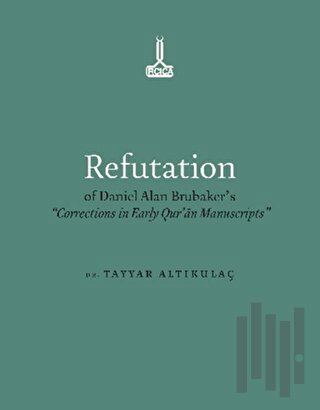
In thecontextof itsprogram ofStudieson the Holy Quran, IRCICA aims topromotescientific research andproducereferencepublicationson the historyof thedissemination of the Holy Quran. A major aspectof this history is that the Holy Quran hasbeen transmittedandpreservedin intact condition. Despite thepassage of more than fourteen centuries since its advent; regardless of the linguistic, orthographic andphonetic variationsdefininglocalpractices of Arabic in different regions, and, although countless copies were produced over the centuries in diverse calligraphic styles and standards, the text and content of the Quran have remained intact. Thepresentbook alsounderlines this fact andfits into this context. It hasbeen preparedby the internationally recognizedscholar in Quranic studies, Dr. Tayyar Altıkulaç, in responsetothebookby Daniel Alan Brubaker titledCorrections in early Qur’ānic ManuscriptsTwentyExamples (Lovettsville:Thinkand TellPress,2019). Brubaker’sbookcan bedescribedasoneof numerouspublicationsauthoredbythe Western writers whoperceivethevarious corrections on scribal errors foundin the earliest copiesof the Quran as changes that could havebeen deliberately made toits text. Brubakerpresents a collection of twenty examples of scribal corrections interpreting them as possible evidence of changes that could have been made at different times in the authentic text of the Quran. The present book by Dr. Tayyar Altıkulaç, on the other hand, discusses and evaluates each and every one of Brubaker’s proposed examples.Through theseevaluations, thebookdemonstrates thatanyclaims, including Brubaker’s, that suggest toraisequestionsabout theintactnessof the Holy Quran, are bound to fail.
In thecontextof itsprogram ofStudieson the Holy Quran, IRCICA aims topromotescientific research andproducereferencepublicationson the historyof thedissemination of the Holy Quran. A major aspectof this history is that the Holy Quran hasbeen transmittedandpreservedin intact condition. Despite thepassage of more than fourteen centuries since its advent; regardless of the linguistic, orthographic andphonetic variationsdefininglocalpractices of Arabic in different regions, and, although countless copies were produced over the centuries in diverse calligraphic styles and standards, the text and content of the Quran have remained intact. Thepresentbook alsounderlines this fact andfits into this context. It hasbeen preparedby the internationally recognizedscholar in Quranic studies, Dr. Tayyar Altıkulaç, in responsetothebookby Daniel Alan Brubaker titledCorrections in early Qur’ānic ManuscriptsTwentyExamples (Lovettsville:Thinkand TellPress,2019). Brubaker’sbookcan bedescribedasoneof numerouspublicationsauthoredbythe Western writers whoperceivethevarious corrections on scribal errors foundin the earliest copiesof the Quran as changes that could havebeen deliberately made toits text. Brubakerpresents a collection of twenty examples of scribal corrections interpreting them as possible evidence of changes that could have been made at different times in the authentic text of the Quran. The present book by Dr. Tayyar Altıkulaç, on the other hand, discusses and evaluates each and every one of Brubaker’s proposed examples.Through theseevaluations, thebookdemonstrates thatanyclaims, including Brubaker’s, that suggest toraisequestionsabout theintactnessof the Holy Quran, are bound to fail.
| Taksit Sayısı | Taksit tutarı | Genel Toplam |
|---|---|---|
| Tek Çekim | 204,00 | 204,00 |




















